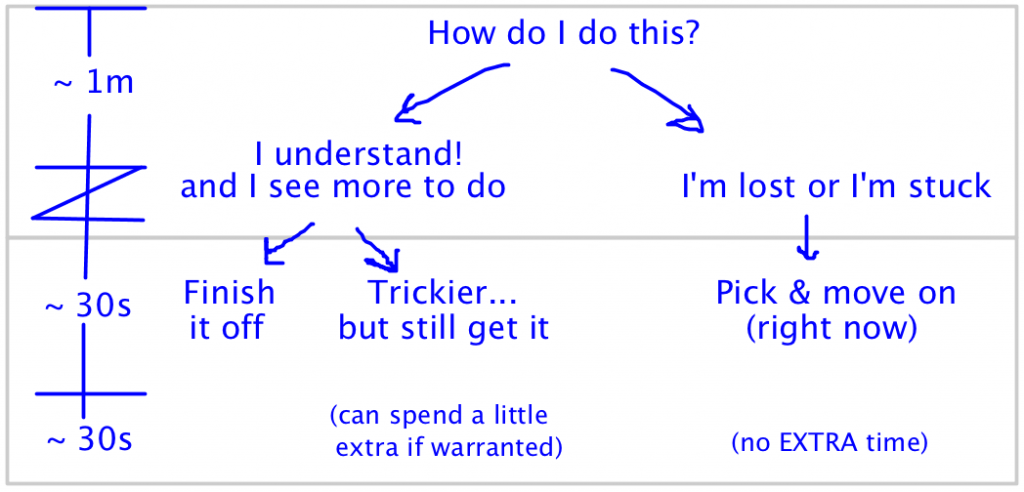-
Target Test Prep's 2024 GMAT Focus Edition prep is discounted for the BTG community!
Redeem
Keep Going? Bail? Decision Making on GMAT SC - Part 2/3
 Last time, we talked about decision-making and time management on the quant section. Its time to talk about verbal! Today, well talk about Sentence Correction. Next time, well dive into Critical Reasoning and Reading Comp.
Last time, we talked about decision-making and time management on the quant section. Its time to talk about verbal! Today, well talk about Sentence Correction. Next time, well dive into Critical Reasoning and Reading Comp.
The SC Decision Tree
Youre going to use two of the same three categories that we discussed in quant. SC question sub-types arent immediately apparent when the sentence pops up on the screen, so the first category (bail immediately when you recognize a sub-type you hate) doesn't apply to SC.
Also note that SC questions should average about 1 minute 20 seconds; some will be faster and some slower than average but generally try not to go above about 2 minutes on one SC. (Note: all times below are approximate. Don't worry about 10 or 15 seconds here and there.)
(1) I get it
I understand whats going on with the original sentence.
(1a) Ive already spotted an error. Im on this!
Decision: Start eliminating! I get it, so I can choose to spend a little extra time if this one is longer / harder than average
Time taken to make decision: About 20 to 30 seconds (+ up to another 90 seconds to keep eliminating)
(1b) Ive spotted something that seems funnyjust not sure why yet.
Decision: Ill keep going, but Im not going to spend extra time on this one unless I suddenly realize I totally get it.
Time taken to make decision: About 20 to 30 seconds (+ up to another 60 to 90 seconds if finding solid errors)
(1c) I dont see a starting point yet.
Decision: Start scanning the answers vertically to look for differences. If I spot something, go to step 1a or step 1b. If not, guess and move on.
Time taken to make decision: About 20 to 30 seconds (+ up to another 60 to 90 seconds if finding solid errors)
(1.5) I narrowed down but am now stuck
This one follows Decision Path (1); its not a separate path. Ive eliminated some answer choices, but Im not sure how to handle any of the remaining differences
Decision: Pick from whats left and move on!
Time taken to make decision: Up to about 1m30s to get to this pointand then 1 second to pick and move on
(2) Huh?
Ive read the sentencetwice!and cant understand the underlying meaning. The whole thing seems nonsensical. Perhaps Ive even tried to plug answer (E) into the full sentence, but Im still lost.
Decision: Is there a good way to make an educated guess? (This is not super common on SC.) If so, I take a little time to think that through and then guess. If not, I pick my favorite letter right now and move on.
Time taken to make decision: About 30 seconds (+ up to another 30 seconds to make an educated guess)
Sentence Correction questions are supposed to average just a little over 1 minute, so how does the 1-minute time sense play out here?
Whats a 1-minute time sense?
Its the ability to know that you started working on the problem approximately one minute agowithout actually having to look at the clock every minute. Youre going to train yourself to know roughly how long one minute is!
If you havent already, read part 1 of this series to learn how to develop your 1-minute time sense.
How do I put together the decision tree and the 1-minute time sense for SC?
Thats the key! Heres what youre going to do.
Your overall keep going or bail decision point is still around the 1-minute mark, but it works very differently on SC than on Quant. Since SC is supposed to average only about 1 minute 20 seconds, you should be close to done with most SCs at the 1-minute mark.
There are three scenarios:
First, you really are almost done. In this case, finish off the problem and move on.
Second, you arent almost done but you understand the sentence, you know whats going on, and you still have more things that you can address. In this case, you may decide to invest an additional 30 to 60 seconds (up to about 2 minutes) in this problem.
Third, you arent almost done and you arent feeling good about the problem. Maybe you dont know how to handle the remaining differences. Maybe you dont feel confident that you understand the full meaning of the sentence. Whatever it is, if youre having an uneasy feeling at this point, then your best strategy is to pick an answer from whatever you havent crossed off yet and move on to the next problem.
How long will it take to master this?
As with quant, expect to spend a solid 4 to 6 weeks working through and practicing the different pieces before it starts to come together and feel more natural. Youll also need to develop a solid sense of when you know how to handle certain differences in the answer choices and when you really dont. Dont get sucked in by the But! feeling.
Eventually, you will have internalized the Business Mindset approach to the GMAT and youll be able to make effective decisions about when to invest extra time on SC and when to move on.
Read the third part of this series to learn about the verbal decision-making process for Critical Reasoning and Reading Comprehension.
Recent Articles
Archive
- May 2024
- April 2024
- March 2024
- February 2024
- January 2024
- December 2023
- November 2023
- October 2023
- September 2023
- July 2023
- June 2023
- May 2023
- April 2023
- March 2023
- February 2023
- January 2023
- December 2022
- November 2022
- October 2022
- September 2022
- August 2022
- July 2022
- June 2022
- May 2022
- April 2022
- March 2022
- February 2022
- January 2022
- December 2021
- November 2021
- October 2021
- September 2021
- August 2021
- July 2021
- June 2021
- May 2021
- April 2021
- March 2021
- February 2021
- January 2021
- December 2020
- November 2020
- October 2020
- September 2020
- August 2020
- July 2020
- June 2020
- May 2020
- April 2020
- March 2020
- February 2020
- January 2020
- December 2019
- November 2019
- October 2019
- September 2019
- August 2019
- July 2019
- June 2019
- May 2019
- April 2019
- March 2019
- February 2019
- January 2019
- December 2018
- November 2018
- October 2018
- September 2018
- August 2018
- July 2018
- June 2018
- May 2018
- April 2018
- March 2018
- February 2018
- January 2018
- December 2017
- November 2017
- October 2017
- September 2017
- August 2017
- July 2017
- June 2017
- May 2017
- April 2017
- March 2017
- February 2017
- January 2017
- December 2016
- November 2016
- October 2016
- September 2016
- August 2016
- July 2016
- June 2016
- May 2016
- April 2016
- March 2016
- February 2016
- January 2016
- December 2015
- November 2015
- October 2015
- September 2015
- August 2015
- July 2015
- June 2015
- May 2015
- April 2015
- March 2015
- February 2015
- January 2015
- December 2014
- November 2014
- October 2014
- September 2014
- August 2014
- July 2014
- June 2014
- May 2014
- April 2014
- March 2014
- February 2014
- January 2014
- December 2013
- November 2013
- October 2013
- September 2013
- August 2013
- July 2013
- June 2013
- May 2013
- April 2013
- March 2013
- February 2013
- January 2013
- December 2012
- November 2012
- October 2012
- September 2012
- August 2012
- July 2012
- June 2012
- May 2012
- April 2012
- March 2012
- February 2012
- January 2012
- December 2011
- November 2011
- October 2011
- September 2011
- August 2011
- July 2011
- June 2011
- May 2011
- April 2011
- March 2011
- February 2011
- January 2011
- December 2010
- November 2010
- October 2010
- September 2010
- August 2010
- July 2010
- June 2010
- May 2010
- April 2010
- March 2010
- February 2010
- January 2010
- December 2009
- November 2009
- October 2009
- September 2009
- August 2009
